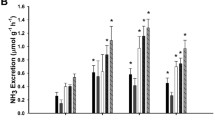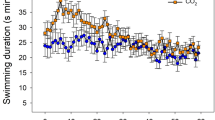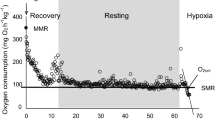Abstract
The changes in ocean chemistry stemming from anthropogenic CO2 release—termed ocean acidification (OA)—are predicted to have wide-ranging effects on fish and ultimately threaten global populations. The ability of fish to adapt to environmental change is currently unknown, but phenotypic plasticity has been highlighted as a crucial factor in determining species resilience. Here we show that red drum, a long-lived estuarine-dependent fish species native to the Gulf of Mexico, exhibit respiratory plasticity that increases CO2 excretion capacity when acclimated to OA conditions. Specifically, fish exposed to 14 days of 1000 µatm CO2 had a 32 % reduction in branchial diffusion distance and increased expression of two putative CO2 channel proteins—rhag and rhcg1. No changes were observed in the erythrocyte CO2 transport pathways. Surprisingly, no significant changes in blood chemistry were observed between acclimated and acutely challenged animals; however, a non-significant 30 % drop in the magnitude of plasma \(C_{{{\text{CO}}_{ 2} }}\) elevation was observed. Reduced diffusion distance also comes with the cost of increased diffusive water loss, which would require greater osmoregulatory investment by the animal. OA exposure induced increased gill Na+, K+ ATPase activity and intestinal nkcc2 expression, supporting both the presumed osmotic stress and increased osmoregulatory investment. However, no differences in standard metabolic rate, maximum metabolic rate or aerobic scope were detected between control and OA acclimated individuals. Similarly, no differences in critical swim speed were detected between groups, suggesting the energetic cost related to respiratory plasticity is negligible against background metabolism. The current study demonstrated that red drum exhibit respiratory plasticity with only mild physiological trade-offs; however, this plasticity is insufficient to fully offset the OA-induced acid–base disturbance and as such is unlikely to impact species resilience.





Similar content being viewed by others
References
Baker DW, Matey V, Huynh KT, Wilson JM, Morgan JD, Brauner CJ (2009) Complete intracellular pH protection during extracellular pH depression is associated with hypercarbia tolerance in white sturgeon, Acipenser transmontanus. Am J Physiol Regul Integr Comp Physiol 296(6):R1868–R1880
Baumann H, Talmage SC, Gobler CJ (2012) Reduced early life growth and survival in a fish in direct response to increased carbon dioxide. Nat Clim Change 2:38–41
Bell G (2013) Evolutionary rescue and the limits of adaptation. Philos Trans R Soc Lond B Biol Sci 368(1610):20120080
Bell WH, Terhune LDB (1970) Water tunnel design for fisheries research. Fisheries Research Board of Canada Technical report no 195. Fisheries Research Board of Canada, Biological Station, Nanaimo
Braun MH, Steele SL, Perry SF (2009) The responses of zebrafish (Danio rerio) to high external ammonia and urea transporter inhibition: nitrogen excretion and expression of rhesus glycoproteins and urea transporter proteins. J Exp Biol 212(Pt 23):3846–3856
Brett JR (1964) The respiratory metabolism and swimming performance of young sockeye salmon. J Fish Res Board Can 21(5):1183–1226
Cai WJ, Hu XP, Huang WJ, Murrell MC, Lehrter JC, Lohrenz SE, Chou WC, Zhai WD, Hollibaugh JT, Wang YC, Zhao PS, Guo XH, Gundersen K, Dai MH, Gong GC (2011) Acidification of subsurface coastal waters enhanced by eutrophication. Nat Geosci 4(11):766–770
Caldeira K, Wickett ME (2003) Oceanography: anthropogenic carbon and ocean pH. Nature 425(6956):365
Cameron JN, Randall DJ (1972) The effect of increased ambient CO2 on arterial CO2 tension, CO2 content and pH in rainbow trout. J Exp Biol 57(3):673–680
Chudzik J, Houston AH (1983) Temperature and erythropoiesis in goldfish. Can J Zoo Revue Canadienne De Zoologie 61(6):1322–1325
Colt J (1984) Computation of dissolved gas concentrations in water as functions of temperature, salinity and pressure. Am Fish S (special publication) 14
Couturier CS, Stecyk JA, Rummer JL, Munday PL, Nilsson GE (2013) Species-specific effects of near-future CO(2) on the respiratory performance of two tropical prey fish and their predator. Comp Biochem Physiol A: Mol Integr Physiol 166(3):482–489
Dickson AG (2010) The carbon dioxide system in seawater: equilibrium chemistry and measurements. In: Riebesell U, Fabry VJ, Hansson L, Gattuso JP (eds) Guide to best practises for ocean acidification research and data reporting. European Commission, Brussels, pp 17–40
Dixson DL, Munday PL, Jones GP (2010) Ocean acidification disrupts the innate ability of fish to detect predator olfactory cues. Ecol Lett 13(1):68–75
Ern R, Huong DTT, Cong NV, Bayley M, Wang T (2014) Effect of salinity on oxygen consumption in fishes: a review. J Fish Biol 84(4):1210–1220
Esbaugh AJ, Perry SF, Bayaa M, Georgalis T, Nickerson J, Tufts BL, Gilmour KM (2005) Cytoplasmic carbonic anhydrase isozymes in rainbow trout Oncorhynchus mykiss: comparative physiology and molecular evolution. J Exp Biol 208:1951–1961
Esbaugh AJ, Perry SF, Gilmour KM (2009) Hypoxia-inducible carbonic anhydrase IX expression is insufficient to alleviate intracellular metabolic acidosis in the muscle of zebrafish, Danio rerio. Am J Physiol Regul Integr Comp Physiol 296(1):R150–R160
Esbaugh AJ, Heuer R, Grosell M (2012) Impacts of ocean acidification on respiratory gas exchange and acid-base balance in a marine teleost, Opsanus beta. J Comp Physiol B 182(7):921–934
Esbaugh AJ, Kristensen T, Takle H, Grosell M (2014) The effects of sustained aerobic swimming on osmoregulatory pathways in Atlantic salmon Salmo salar smolts. J Fish Biol 85(5):1355–1368
Feely RA, Alin SR, Newton J, Sabine CL, Warner M, Devol A, Krembs C, Maloy C (2010) The combined effects of ocean acidification, mixing, and respiration on pH and carbonate saturation in an urbanized estuary. Estuar Coast Shelf Sci 88(4):442–449
Frommel A, Maneja R, Lowe D, Malzahn AM, Geffen AJ, Folkvord A, Piatkowski U, Reusch TBH, Clemmesen C (2012) Severe tissue damage in Atlantic cod larvae under increasing ocean acidification. Nat Clim Change 2:42–46
Genz J, Esbaugh AJ, Grosell M (2011) Intestinal transport following transfer to increased salinity in an anadromous fish (Oncorhynchus mykiss). Comp Biochem Physiol A Mol Integr Physiol 159(2):150–158
Gilmour KM, Perry SF, Esbaugh AJ, Genz J, Taylor JR, Grosell M (2012) Compensatory regulation of acid-base balance during salinity transfer in rainbow trout (Oncorhynchus mykiss). J Comp Physiol B-Biochem Syst Environ Physiol 182(2):259–274
Gonzalez A, Ronce O, Ferriere R, Hochberg ME (2013) Evolutionary rescue: an emerging focus at the intersection between ecology and evolution. Philos Trans R Soc Lond B Biol Sci 368(1610):20120404
Grans A, Jutfelt F, Sandblom E, Jonsson E, Wiklander K, Seth H, Olsson C, Dupont S, Ortega-Martinez O, Einarsdottir I, Bjornsson BT, Sundell K, Axelsson M (2014) Aerobic scope fails to explain the detrimental effects on growth resulting from warming and elevated CO2 in Atlantic halibut. J Exp Biol 217(Pt 5):711–717
Green L, Jutfelt F (2014) Elevated carbon dioxide alters the plasma composition and behaviour of a shark. 10(9)
Grosell M, Farrell AP, Brauner CJ (eds) (2011) The role of the gastrointestinal tract in salt and water balance, vol 30. Fish physiology, vol. 30: The multifunctional gut of fish. Elsevier, Inc., London, UK, Burlington, MA, San Diego, CA
Guffey S, Esbaugh A, Grosell M (2011) Regulation of apical H+-ATPase activity and intestinal HCO3 − secretion in marine fish osmoregulation. Am J Physiol Regul Integr Comp Physiol 301(6):R1682–R1691
Heinrich DDU, Rummer JL, Morash AJ, Watson S, Simpfendorfer CA, Heupel MR, Munday PL (2014) A product of its environment: the epaulette shark (Hemiscyllium ocellatum) exhibits physiological tolerance to elevated environmental CO2. Conserv Physiol 2:1–12
Henriksson P, Mandic M, Richards JG (2008) The osmorespiratory compromise in sculpins: impaired gas exchange is associated with freshwater tolerance. Physiol Biochem Zool 81(3):310–319
Henry RP (1991) Techniques for measuring carbonic anhydrase activity in vitro. In: Dodgson SJ, Tashian RE, Gros G, Carter ND (eds) The carbonic anhydrases: cellular physiology and molecular genetics. Plenum, New York, pp 119–131
Heuer RM, Grosell M (2014) Physiological impacts of elevated carbon dioxide and ocean acidification on fish. Am J Physiol Regul Integr Comp Physiol
Heuer RM, Esbaugh AJ, Grosell M (2012) Ocean acidification leads to counterproductive intestinal base loss in the gulf toadfish (Opsanus beta). Physiol Biochem Zool 85(5):450–459
Hofmann GE, Todgham AE (2010) Living in the now: physiological mechanisms to tolerate a rapidly changing environment. Annu Rev Physiol 72:127–145
Janssen RG, Randall DJ (1975) The effects of changes in pH and PCO2 in blood and water on breathing in rainbow trout, Salmo gairdneri. Respir Physiol 25(2):235–245
Kelly MW, Hofmann GE (2013) Adaptation and the physiology of ocean acidification. Funct Ecol 27(4):980–990
Kelly MW, Padilla-Gamino JL, Hofmann GE (2013) Natural variation and the capacity to adapt to ocean acidification in the keystone sea urchin Strongylocentrotus purpuratus. Glob Chang Biol 19(8):2536–2546
Lund SG, Phillips MCL, Moyes CD, Tufts BL (2000) The effects of cell ageing on protein synthesis in rainbow trout (Oncorhynchus mykiss) red blood cells. J Exp Biol 203:2219–2228
Marshall WS, Grosell M (2006) Ion transport, osmoregulation, and acid–base balance. In: Evans DH, Claiborne JB (eds) The physiology of fishes, 3rd edn. Taylor and Francis Group, New York, pp 177–230
McCormick SD (1993) Methods for non-lethal biopsy and measurement of Na+, K+ ATPase activity. Can J Fish Aquat Sci 50(3):656–658
Melzner F, Gobel S, Langenbuch M, Gutowska MA, Portner HO, Lucassen M (2009) Swimming performance in Atlantic Cod (Gadus morhua) following long-term (4–12 months) acclimation to elevated seawater PCO2. Aquat Tox 92(1):30–37
Melzner F, Thomsen J, Koeve W, Oschlies A, Gutowska MA, Bange HW, Hansen HP, Kortzinger A (2013) Future ocean acidification will be amplified by hypoxia in coastal habitats. Mar Biol 160(8):1875–1888
Miller GM, Watson S, Donelson JM, McCormick MI, Munday PL (2012) Parental environment mediates impacts of increased carbon dioxide on a coral reef fish. Nat Clim Change 2:858–861
Munday PL, Crawley NE, Nilsson GE (2009a) Interacting effects of elevated temperature and ocean acidification on the aerobic performance of coral reef fishes. Mar Ecol Prog Ser 388:235–242
Munday PL, Dixson DL, Donelson JM, Jones GP, Pratchett MS, Devitsina GV, Doving KB (2009b) Ocean acidification impairs olfactory discrimination and homing ability of a marine fish. Proc Natl Acad Sci USA 106(6):1848–1852
Munday PL, Dixson DL, McCormick MI, Meekan M, Ferrari MC, Chivers DP (2010) Replenishment of fish populations is threatened by ocean acidification. Proc Natl Acad Sci USA 107(29):12930–12934
Nakada T, Westhoff CM, Kato A, Hirose S (2007) Ammonia secretion from fish gill depends on a set of Rh glycoproteins. FASEB J 21(4):1067–1074
Nilsson GE, Dixson DL, Domenici P, McCormick MI, Sorensen C, Watson S, Munday PL (2012) Near-future carbon dioxide levels alter fish behaviour by interfering with neurotransmitter function. Nat Clim Change 2:201–204
Pan TC, Applebaum SL, Manahan DT (2015) Experimental ocean acidification alters the allocation of metabolic energy. Proc Natl Acad Sci USA 112(15):4696–4701
Perry SF (1986) Carbon dioxide excretion in fishes. Can J Zool 64:565–572
Perry SF, Esbaugh A, Braun M, Gilmour KM (2009) Gas transport and gill function in water-breathing fish. In: Glass ML, Wood SC (eds) Cardio-respiratory control in vertebrates. Springer-Verlag, Berlin, pp 5–42
Perry SF, Braun MH, Noland M, Dawdy J, Walsh PJ (2010) Do zebrafish Rh proteins act as dual ammonia-CO2 channels? J Exp Zool A Ecol Genet Physiol 313(9):618–621
Pespeni MH, Sanford E, Gaylord B, Hill TM, Hosfelt JD, Jaris HK, LaVigne M, Lenz EA, Russell AD, Young MK, Palumbi SR (2013) Evolutionary change during experimental ocean acidification. Proc Natl Acad Sci USA 110(17):6937–6942
Pfister CA, Esbaugh AJ, Frieder CA, Baumann H, Bockmon EE, White MM, Carter BR, Benway HM, Blanchette CA, Carrington E, McClintock JB, McCorkle DC, McGillis WR, Mooney TA, Ziveri P (2014) Detecting the unexpected: a research framework for ocean acidification. Environ Sci Technol 48(17):7053–7061
Rummer JL, Stecyk JAW, Courturier CS, Watson S, Nilsson GE, Munday PL (2013) Elevated CO2 enhances aerobic scope of a coral reef fish. Conserv Physiol 1:1–7
Steffensen JF, Johansen K, Bushnell PG (1984) An automated swimming respirometer. Comp Biochem Physiol 79(3):437–440
Strobel A, Bennecke S, Leo E, Mintenbeck K, Portner HO, Mark FC (2012) Metabolic shifts in the Antarctic fish Notothenia rossii in response to rising temperature and PCO2. Front Zool 9(1):28
Strobel A, Graeve M, Poertner HO, Mark FC (2013) Mitochondrial acclimation capacities to ocean warming and acidification are limited in the antarctic Nototheniid Fish, Notothenia rossii and Lepidonotothen squamifrons. PLoS One 8(7):e68865
Tufts B, Perry SF (1998) Carbon dioxide transport and excretion. Fish physiology. Fish respiration, vol 17. Academic Press, San Diego, pp 229–282
Tzaneva V, Gilmour KM, Perry SF (2011) Respiratory responses to hypoxia or hypercapnia in goldfish (Carassius auratus) experiencing gill remodelling. Respir Physiol Neurobiol 175(1):112–120
Wallace RB, Baumann H, Grear JS, Aller RC, Gobler CJ (2014) Coastal ocean acidification: the other eutrophication problem. Estuar Coast Shelf Sci 148:1–13
Watson CJ, Nordi WM, Esbaugh AJ (2014) Osmoregulation and branchial plasticity after acute freshwater transfer in red drum, Sciaenops ocellatus. Comp Biochem Physiol A Mol Integr Physiol 178:82–89
White CR, Phillips NF, Seymour RS (2006) The scaling and temperature dependence of vertebrate metabolism. Biol Lett 2(1):125–127
Wood C, Hopkins T, Walsh P (1997) Pulsatile urea excretion in the toadfish (Opsanus beta) is due to a pulsatile excretion mechanism, not a pulsatile production mechanism. J Exp Biol 200(Pt 6):1039–1046
Wood CM, Iftikar FI, Scott GR, De Boeck G, Sloman KA, Matey V, Valdez Domingos FX, Duarte RM, Almeida-Val VM, Val AL (2009) Regulation of gill transcellular permeability and renal function during acute hypoxia in the Amazonian oscar (Astronotus ocellatus): new angles to the osmorespiratory compromise. J Exp Biol 212(Pt 12):1949–1964
Acknowledgments
Funding for this work was provided by a National Science Foundation award (EF 1315290) to AJE. Additional support for WMN was provided by de Amparo à Pesquisa do Estado de São Paulo (FAPESP—2013/12950-3) and for ASJ through the University of Texas at Austin Semester by the Sea program. The authors have no conflicts of interest with respect to this work.
Author information
Authors and Affiliations
Corresponding author
Additional information
Communicated by H.V. Carey.
Electronic supplementary material
Below is the link to the electronic supplementary material.
Rights and permissions
About this article
Cite this article
Esbaugh, A.J., Ern, R., Nordi, W.M. et al. Respiratory plasticity is insufficient to alleviate blood acid–base disturbances after acclimation to ocean acidification in the estuarine red drum, Sciaenops ocellatus . J Comp Physiol B 186, 97–109 (2016). https://doi.org/10.1007/s00360-015-0940-6
Received:
Revised:
Accepted:
Published:
Issue Date:
DOI: https://doi.org/10.1007/s00360-015-0940-6




